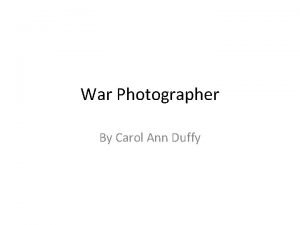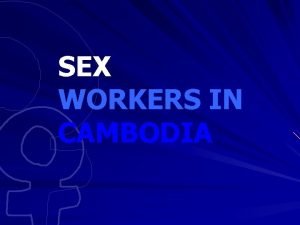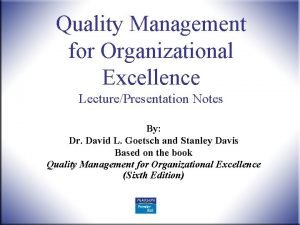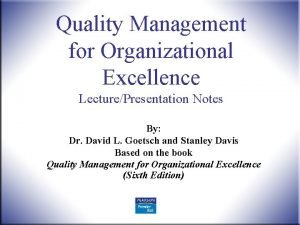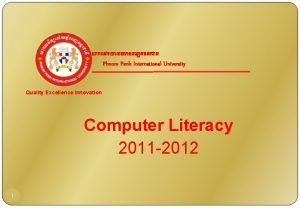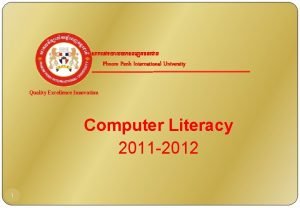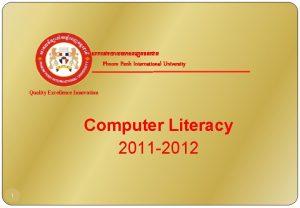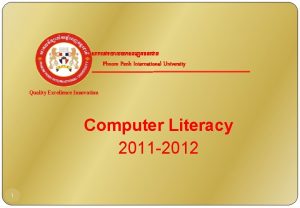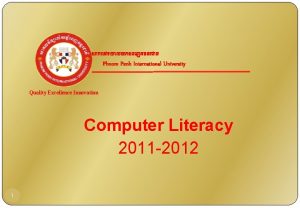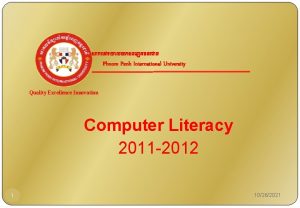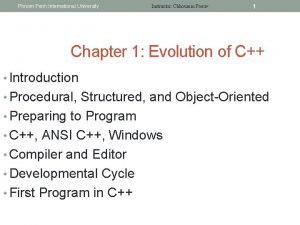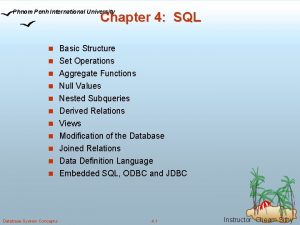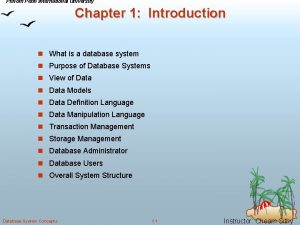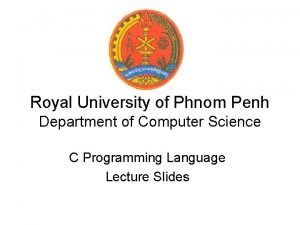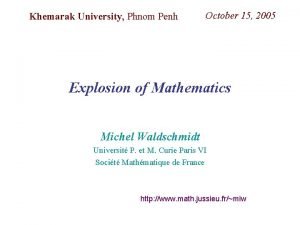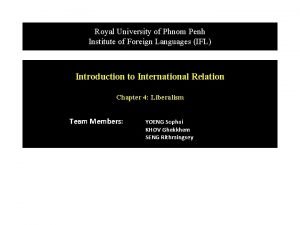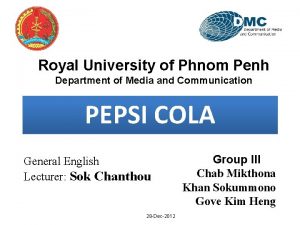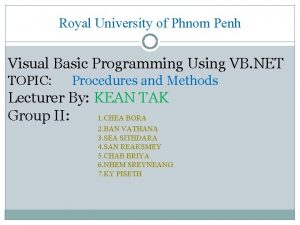Phnom Penh International University Quality Excellence Innovation Computer


















- Slides: 18

ស កលវទយ លយភនព ញអនតរជ ត Phnom Penh International University Quality Excellence Innovation Computer Literacy 2011 -2012 1

Chapter 7 Data Processing 2

Objectives After this chapter, students would be able to: • Data vs. Information • Computer represent data • File Processing Concept and Organization 3

The difference between Data and information Data is/are the facts of the World For example, take yourself. You may be 5 ft tall, have brown hair and blue eyes. All of this is “data”. You have brown hair whether this is written down somewhere or not. 4

The difference between Data and information z. Information z Information is data has been processed z Here is a simple analogy for you z If I take a picture of you, the photograph is information. But what you look like is data. In Brief Data: Facts, a description of the World Information: Captured Data and 5 Knowledge

HOW COMPUTERS REPRESENT DATA to a computer numbers, letters, sounds, and pictures are all represented by zeros (0) and ones (1) in a computer all data must be reduced to electrical switches a switch has only two states - "ON" (1) and "OFF" (0) the computer uses the binary numbering system 6

BIT and BYTE Bit - binary digit - smallest possible unit of data Nibbles A nibble is a collection of four bits With a nibble, we can represent up to 16 distinct values. 7

BIT and BYTE Byte - group of 8 bits - using various ON (1)/OFF(0) combinations 256 different values can be expressed values from 0 to 255 represent uppercase letters, lowercase letters, numbers, punctuation, and other symbols 8

Text Codes Early programmers realized that they needed a standard text code Text is represented by number The standard code system would enable any programmer or program to use the same combinations of number to represent the same individual pieces of data. 9

Text Codes ASCII EBCDIC Unicode are three of the most popular text code systems invented. 10

ASCII ANSI’s solution to representing symbols with bits of data was the ASCII character set ACSII (pronounced AS-key) stands for American Standard Code for Information Interchange ACSII an 8 -bit code that specify characters up to only 127 and different characters sets for codes 128 through 255. 11

EBCDIC (Extended Binary Coded Decimal Information Code) The BCD (binary coded decimal) system, defined by IBM for one of its early computers Was one of the first complete systems to represent symbols with bits. BCD codes consisted of 6 -bit codes, which allowed a maximum of sixty-four possible symbols. BCD computers could work only with uppercase letters and with very few other symbols 12

EBCDIC (Extended Binary Coded Decimal Information Code) The need to represent more characters led to IBM’s development of the EBCDIC system EBCDIC (Pronounced EB-si-dic) stand for Extended Binary Coded Decimal Information Code EBCDIC is an 8 -bit code that defines 255 symbols By the time small computers were being developed, the American National Standards 13 Institute (ANSI) had begun to define new text

ISO The International Standard s Organization expanded on the ASCII character set, To offer different sets of characters for different language group this organization works to establish international standards and publish documents describing each technology, ISO 8859 -1 covers Western European languages. 14

Unicode An evolving standard for data representation called Unicode Worldwide Character Standard, provide 2 bytes-16 bits to represent each letter, number, or symbol With 2 bytes, enough Unicodes can be created more than 65, 536 different characters or symbols 15 This total is enough for every unique

Unicode Including the vast Chinese, Korean, and Japanese The Unicode standard was developed in 1991 by a joint engineering team from Apple Computer Corporation and Xerox Corporation 16

Character 0 1 2 3 4 5 6 7 8 9 17 Binary 011 0000 011 0001 011 0010 011 011 0100 011 0101 0110 0111 011 1000 011 1001 Dec 48 49 50 51 52 53 54 55 56 57 Character a b c d e f g h i j k l m n o p q r s t u v w x y z Binary 110 0001 110 0010 110 0011 110 0100 110 0101 110 0110 0111 110 1000 110 1001 110 1010 1011 1100 1101 110 110 1111 0000 111 0001 111 0010 111 0011 111 0100 111 0101 111 0110 111 0111 1000 111 1001 111 1010 Dec 97 98 99 100 101 102 103 104 105 106 107 108 109 110 111 112 113 114 115 116 117 118 119 120 121 122 Character A B C D E F G H I J K L M N O P Q R S T U V W X Y Z Binary 100 0001 100 0010 100 0011 100 0100 0101 100 0110 100 0111 1000 1001 100 1010 1011 100 100 1101 100 1110 100 1111 101 0000 101 0001 101 0010 101 0011 101 0100 101 0101 0110 101 0111 1000 101 101 1010 Dec 65 66 67 68 69 70 71 72 73 74 75 76 77 78 79 80 81 82 83 84 85 86 87 88 89 90

File Organization A Folder, Directory, Catalog, or drawer, is a virtual container originally derived from which groups of computer files and other folders can be kept and organized. 18
 Air quality phnom penh
Air quality phnom penh Carol ann duffy war photographer friend
Carol ann duffy war photographer friend Phnom penh hookers
Phnom penh hookers National pediatric hospital cambodia
National pediatric hospital cambodia Innovation for the sake of innovation
Innovation for the sake of innovation Radical vs disruptive innovation
Radical vs disruptive innovation Quality management for organizational excellence
Quality management for organizational excellence Quality management for organizational excellence
Quality management for organizational excellence Quality and innovation in product and process design
Quality and innovation in product and process design Focus quality innovation
Focus quality innovation Entrepreneurship and innovation bangalore university
Entrepreneurship and innovation bangalore university Quality control and quality assurance
Quality control and quality assurance Pmp quality management
Pmp quality management Quality metrics pmp
Quality metrics pmp Total quality management seminar
Total quality management seminar Quality improvement vs quality assurance
Quality improvement vs quality assurance Concept of quality assurance
Concept of quality assurance Philip crosby formulated the seven deadly diseases
Philip crosby formulated the seven deadly diseases Quality is free: the art of making quality certain
Quality is free: the art of making quality certain

